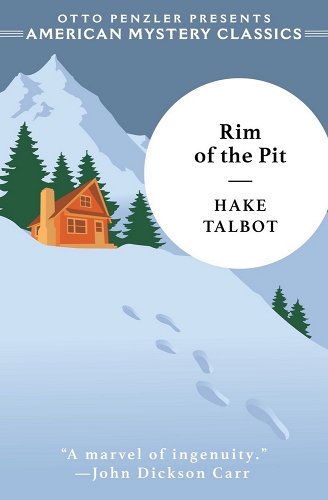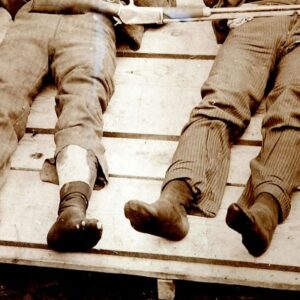From the very first sentence…we are into the realm of nightmare. Miracles gather and explode. A dead man returns—or does not return. A flying ghost, apparently, swoops down and attacks. No angels, but goblins and wizards seem to dance on a pin. “Rim of the Pit” is a beauty.
–John Dickson Carr
This may be the first you’ve heard of Rim of the Pit and its author Hake Talbot. But as indicated by the above quote from his review of Talbot’s 1944 gem, it was held in high esteem by John Dickson Carr, acknowledged master of the locked room mystery. In the early nineteen-eighties, a panel of experts selected by Edward D. Hoch—no stranger himself to impossible murders in hunting lodges and snowbound cabins—voted it second only to Carr’s own masterpiece The Hollow Man (known to American readers as The Three Coffins) as landmarks of that sub-genre.
But to call Rim of the Pit a locked room mystery barely begins to describe this outré and unrelenting “long night’s journey into Hades.” For while it contains many components of a Golden Age classic—relatives and relative strangers are sequestered at a remote lodge in the wilderness during a fiendish blizzard and one of them is brutally murdered—there is nothing even remotely cozy about this avalanche of impossible events. Enough plasma is spilled to satiate the most hematophagous reader, topped off by the discovery of a body fully drained of blood. Both demonic possession and the flesh-eating “Windigo” (mythological winter monster of indigenous tribes of North America) are given serious consideration as the agents of murder. Rarely has the supernatural been accommodated so credibly and articulately in a mystery, to such an extent that you may find yourself agreeing with the characters that a deceased person might qualify as an ongoing suspect.
At times teetering on the brink of horror, Talbot further lends his mystery the pernicious aura of a textbook of Forbidden Arts with the epigraphs that commence each chapter, several times quoting Eliphas Levi, a nineteenth-century occultist who wove his Doctrine and Ritual of High Magic around the tarot deck and alchemy. The book begins to feel dangerous in one’s hands as the unholy implausible transmutes into the wholly feasible, especially if you’re reading Rim of the Pit in “those hours of darkness when the powers of evil are exalted”—quoting Conan Doyle and The Hound of the Baskervilles . . . and, of course, a supernaturally-attuned black hound named Thor figures in the story just for good measure.
If a whodunit is a mystery, then a howdunit is a magic act, and Rim of the Pit is a howdunit written by a magician. “Hake Talbot” was the pen name of Henning Nelms, a bona fide Renaissance man: attorney, advertising expert, college drama professor, and author of tomes on the stagecraft of magic, set design, and old-fashioned melodrama. His Magic and Showmanship: A Handbook for Conjurors was not a book of magic tricks but a serious guide for professional magicians seeking to infuse their performances (or staged séances) with the same approaches and techniques used in legitimate theatre.
Thus, it’s hardly surprising if, while reading Rim of the Pit, one might envision a bravura stage thriller, its cast of ten trapped by the elements in an impressively handsome two-level cabin set. The plot hits the ground running for dear life with the memorable first sentence: “I came up here to make a dead man change his mind.” And when we immediately learn that these Ten Little Individuals have assembled to hold a séance—not a harmless parlor game for an evening’s diversion but a concerted attempt to make contact with someone from beyond the grave—we expect the evening may quickly go south . . . assuming the pit of Hell is a compass point.
There are indications that Hake Talbot, who was forty-four when Rim was published, knew his John Dickson Carr, who specialized in impossible crimes that often bore the stage dressing of the preternatural until well into his detective’s final summation. In The Hollow Man, published ten years before Rim, a Professor Charles Grimaud is murdered in inexplicable fashion; in Talbot’s tale, a character central to the mystery bears the name Grimaud Désanat—please also note the last name is an anagram of “de Satan.” Talbot’s Grimaud may or may not be dead but, in his macabre tale, it matters little: dead or alive, he’s still a suspect!
And just as in The Hollow Man there is a legendary chapter devoted to a discussion of the genre by detective Gideon Fell himself, Rim contains several fascinating sidebars about the mechanics of magic, with particular emphasis on phony séances; these play out not as digression but informed discourse among the characters relevant to the nightmarish events unfolding. Yet even this discussion of the fakery behind some phony mediums’ ghostly effects only makes us more seriously ponder if genuine supernatural elements are at play here . . . much like the magician’s device of “exposing” to the audience how a miraculous feat was accomplished, only to repeat the trick minus the revealed flummery and miraculously achieving the same results.
Finally, both Hollow and Rim feature corpses discovered upon a field of unblemished snow, the apparent victims of gunshot wounds; how could they have been wounded when there are no footprints anywhere near the body? Rest assured the explanations offered are as wildly divergent in both books as are the two author’s voices throughout.
It will not betray any secrets to reveal that the role of detective in this extraordinary mystery is taken by one Rogan Kincaid, although for the first few chapters you might have considered him a suspect until a footnote reveals that he was central to the author’s previous mystery, The Haunted Hangman—this being the only other novel penned by “Hake Talbot.”
Kincaid is introduced as a professional gambler, adventurer, and apparent rake (the novel boasts not one but two surprisingly amenable young women who may have raised readers’ eyebrows or pulses in the years just prior to Mickey Spillane). As the mystery deepens, Kincaid at times blends into the background, more like another “man who explained miracles,” G.K. Chesterton’s Father Brown, who could go unnoticed amid impossible crimes until quietly weighing in with an observation that sends the scenery crashing down upon the stage. But once the snowstorm and deaths subside, Kincaid takes charge to offer a way out of the abyss for those who have survived the night, as well as an explanation of the night itself for an audience of one (plus you, of course).
In his textbook Magic and Showmanship, Henning Nelms asserts that “the art of conjuring consists in creating illusions of the impossible.” Under the nom de plume of Hake Talbot, he conjured up the grand illusion that is Rim of the Pit. And before you begin reading his tour de force, let me hijack one of Sherlock Holmes’ most famous observations by way of advice: when you have eliminated all which is impossible, you may have eliminated too much.
Hey, it’s really snowing up a blizzard, isn’t it? Better toss another log on the fire . . . and if you must step outside, make sure to bundle up. You could catch your death out there.
***



















